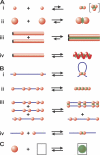The depletion attraction: an underappreciated force driving cellular organization
- PMID: 17145959
- PMCID: PMC2064666
- DOI: 10.1083/jcb.200609066
The depletion attraction: an underappreciated force driving cellular organization
Abstract
Cellular structures are shaped by hydrogen and ionic bonds, plus van der Waals and hydrophobic forces. In cells crowded with macromolecules, a little-known and distinct force-the "depletion attraction"-also acts. We review evidence that this force assists in the assembly of a wide range of cellular structures, ranging from the cytoskeleton to chromatin loops and whole chromosomes.
Figures


Similar articles
-
The origin of long-range attraction between hydrophobes in water.Biophys J. 2007 Jan 15;92(2):373-8. doi: 10.1529/biophysj.106.087023. Epub 2006 Sep 22. Biophys J. 2007. PMID: 16997876 Free PMC article.
-
Hydrophobic attraction between silanated silica surfaces in the absence of bridging bubbles.Langmuir. 2012 Oct 2;28(39):13952-9. doi: 10.1021/la303037d. Epub 2012 Sep 17. Langmuir. 2012. PMID: 22931235
-
Strong attraction among the fully hydrophilic {Mo72Fe30} macroanions.J Am Chem Soc. 2005 May 18;127(19):6942-3. doi: 10.1021/ja0510966. J Am Chem Soc. 2005. PMID: 15884924
-
Non-specific (entropic) forces as major determinants of the structure of mammalian chromosomes.Chromosome Res. 2011 Jan;19(1):53-61. doi: 10.1007/s10577-010-9150-y. Chromosome Res. 2011. PMID: 20714801 Review.
-
The crowded nucleus.Int Rev Cell Mol Biol. 2014;307:15-26. doi: 10.1016/B978-0-12-800046-5.00002-3. Int Rev Cell Mol Biol. 2014. PMID: 24380591 Review.
Cited by
-
Phosphates form spectroscopically dark state assemblies in common aqueous solutions.Proc Natl Acad Sci U S A. 2023 Jan 3;120(1):e2206765120. doi: 10.1073/pnas.2206765120. Epub 2022 Dec 29. Proc Natl Acad Sci U S A. 2023. PMID: 36580589 Free PMC article.
-
Phase behaviour of a dispersion of charge-stabilised colloidal spheres with added non-adsorbing interacting polymer chains.Eur Phys J E Soft Matter. 2008 Oct;27(2):171-84. doi: 10.1140/epje/i2008-10367-6. Epub 2008 Sep 16. Eur Phys J E Soft Matter. 2008. PMID: 18791755
-
Aqueous Triple-Phase System in Microwell Array for Generating Uniform-Sized DNA Hydrogel Particles.Front Genet. 2021 Jul 23;12:705022. doi: 10.3389/fgene.2021.705022. eCollection 2021. Front Genet. 2021. PMID: 34367260 Free PMC article.
-
Editorial: Mechanobiology of biofilms and associated host -pathogen interactions.Front Cell Infect Microbiol. 2024 Apr 23;14:1416131. doi: 10.3389/fcimb.2024.1416131. eCollection 2024. Front Cell Infect Microbiol. 2024. PMID: 38716197 Free PMC article. No abstract available.
-
Nuclear export dynamics of RNA-protein complexes.Nature. 2011 Jul 20;475(7356):333-41. doi: 10.1038/nature10318. Nature. 2011. PMID: 21776079 Free PMC article. Review.
References
-
- Adams, M., Z. Dogic, S.L. Keller, and S. Fraden. 1998. Entropically driven microphase transitions in mixtures of colloidal rods and spheres. Nature. 393:349–352.
-
- Altan-Bonnet, N., R. Sougrat, and J. Lippincott-Schwartz. 2004. Molecular basis for Golgi maintenance and biogenesis. Curr. Opin. Cell Biol. 16:364–372. - PubMed
-
- Asakura, S., and F. Oosawa. 1958. Interactions between particles suspended in solutions of macromolecules. J. Polym. Sci. [B]. 33:183–192.
-
- Barber, B.J., R.A. Babbitt, S. Parameswaran, and S. Dutta. 1995. Age- related changes in rat interstitial matrix hydration and serum proteins. J. Gerontol. A. Biol. Sci. Med. Sci. 50:B282–B287. - PubMed
Publication types
MeSH terms
Substances
Grants and funding
LinkOut - more resources
Full Text Sources
Other Literature Sources

